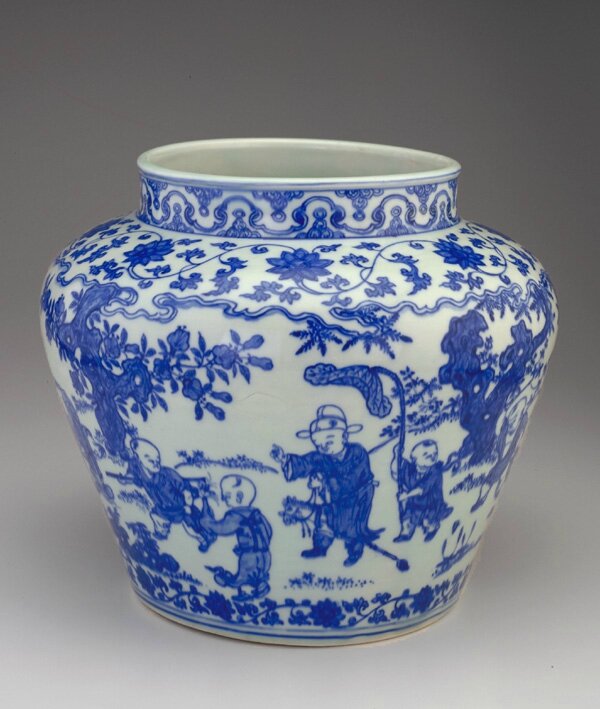Jar of guan shape, 1522-1566, Ming dynasty, Jiajing reign
Jar of guan shape, 1522-1566, Ming dynasty, Jiajing reign. Porcelain with cobalt decoration under colorless transparent glaze. H: 26.6 W: 32.0 cm. Jingdezhen, China. Purchase F1962.16. Freer/Sackler © 2014 Smithsonian Institution
From the late fifteenth century onward, porcelains exhibited increasing diversity in decorative styles and techniques (such as application of enamel glzes directly to the fired porcelain body). This tendancy culminated in the varied output of the Chia-ching period (1522-1566). Thereafter, scale of production gradually began to overwhelm quality. Much blue-and-white porcelain produced at the end fo the Ming dynasty was directed toward a European market, as reflected in the European shapes made to order.
Depicted on this jar, sixteen male children—their mothers'pride and joy—play in an abstracted garden setting, which serves like a stage set to frame the children's activities. All the boys wear their hair in tufts as a sign of youth, while most of the older ones are depicted with jewelry, including amulet necklaces. Separated by large trees and craggy rock formations, some of the children have taken up various adult occupations, including music making, gathering herbs, and riding to town as a successful official. Others concentrate on catching crickets. A cloud-shaped band above suggests a horizon line, while small plants indicate the terrain of this highly stylized landscape.

/https%3A%2F%2Fprofilepics.canalblog.com%2Fprofilepics%2F1%2F0%2F100183.jpg)
/https%3A%2F%2Fstorage.canalblog.com%2F03%2F02%2F119589%2F96711876_o.jpg)
/https%3A%2F%2Fstorage.canalblog.com%2F11%2F31%2F119589%2F94773502_o.jpg)
/https%3A%2F%2Fstorage.canalblog.com%2F20%2F83%2F119589%2F94772815_o.jpg)
/https%3A%2F%2Fstorage.canalblog.com%2F26%2F72%2F119589%2F75604929_o.jpg)
/https%3A%2F%2Fstorage.canalblog.com%2F59%2F60%2F119589%2F26458628_o.jpg)



/image%2F1371349%2F20240506%2Fob_0ac115_441883710-1664459127657433-82227069902.jpg)
/image%2F1371349%2F20240506%2Fob_d2d810_441853969-1664462427657103-87847731357.jpg)
/image%2F1371349%2F20240506%2Fob_d57c6b_441421099-1663668671069812-87585335785.jpg)
/image%2F1371349%2F20240506%2Fob_8bb9ad_440933698-1663666584403354-39401337402.jpg)